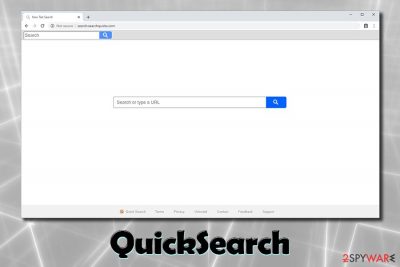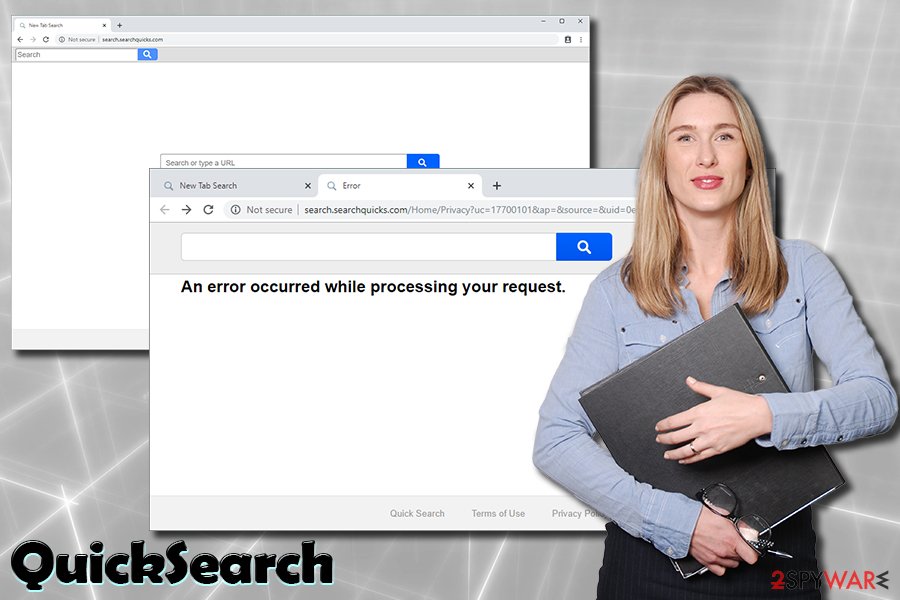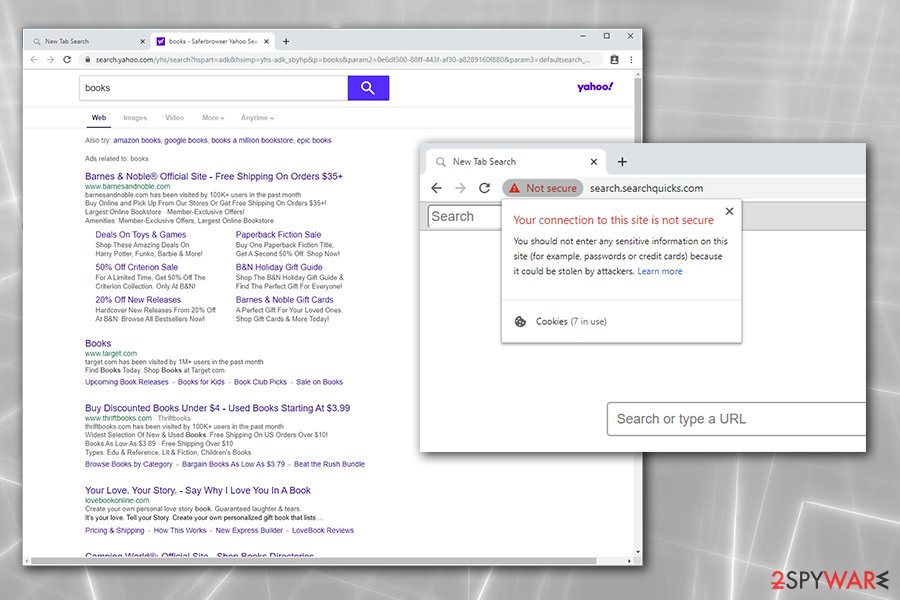QuickSearch virus (Removal Instructions) - Nov 2019 update
QuickSearch virus Removal Guide
What is QuickSearch virus?
QuickSearch virus is a potentially unwanted program that hijacks all the installed browsers by changing their settings

QuickSearch is a browser hijacker[1] that users might install unintentionally during the installation of freeware or after being tricked by an attractive ad online. Once inside the system, the potentially unwanted program attaches an extension to Google Chrome, Mozilla Firefox, Safari, or Internet Explorer and sets the homepage, new tab address, and the search engine to hxxp://search.searchquicks.com.
After the QuickSearch hijack, users will experience the symptoms straight away, including sponsored links at the top of search results (searchers are redirected to Yahoo, although the results are not organic),[2] increased amount of advertisements on all visited websites – they are usually marked as “QuickSearch ads” or “Sponsored ads” – and also slowdown of the browser. The underlying effects of the PUP are that it tracks various information about the affected users and uses it for marketing purposes.
| Name | QuickSearch |
| Type | Browser hijacker, potentially unwanted program |
| Homepage assigned to | hxxp://search.searchquicks.com |
| Infiltration | Users install browser hijackers or other PUPs via software bundles downloaded from third-party sites |
| Symptoms | Changes to web browser settings, including homepage, new tab address, and the search engine; sponsored links at the top of the search results; the increased amount of ads on most visited websites, etc. |
| Risks | Users may install other potentially unwanted programs, disclose personal information to unknown parties, waste money on useless programs/services, etc. |
| Termination | You can opt to delete the browser hijacker by using security software or by checking our manual removal guide below |
| Optimization & recovery | Potentially unwanted programs might leave unwanted changes on the infected machine. For that reason, the OS might start showing errors or crashing. To avoid that, we recommend scanning the device with FortectIntego. Additionally, browser reset is also highly advised |
Another suspicious trait of QuickSearch is that it does not provide its Privacy Policy (or Terms of Service) on the official website. While the links are present, once clicked, the browser redirects to an error page which reads:
An error occurred while processing your request.
However, this is not a browser or connection error – these were placed deliberately in order to avoid any legal requirements that all the applications should have according to safety regulations. In other words, QuickSearch does not indicate what the rules of using their products are, neither does it provide any information about personal data retention.
It might be possible that QuickSearch data gathering is not safely stored appropriately (i.e., not encrypted),[3] or that it gathers much more than it should. For example, harvesting such data as email, name, and credit card details without prior approval from the user is illegal – that is what malware does. QuickSearch virus is a term that is appropriate for an app that does not provide legal documents and is gathering information in the background.
Because QuickSearch is a browser hijacker, it is likely gathering the following browsing-related information:
- Technical details about the device
- OS and browser version
- IP and ISP
- Browser cookie data
- Links clicked
- Bookmarks added
- Search queries, etc.
Such data is often collected for marketing purposes – in order to ensure targeted advertising works. However, there is no way to guarantee that the links presented to end-users are safe. For example, users might end up on phishing, tech support scam, or similar sites that seek to obtain users' personal information or make them download unsafe programs.

Unfortunately, in the majority of cases, QuickSearch ads lead users to predetermined third-party websites that are not even related to the ad content. In other words, these ads are meant to drive traffic to particular websites and make them more popular. Whenever you see an ad, ignore it and proceed with QuickSearch removal.
The quickest way to remove QuickSearch is by scanning your machine with anti-malware software, which includes the capability of detecting potentially unwanted programs. Alternatively, you can rely on our manual removal instructions below. For the best results, experts[4] also recommend scanning the machine with FortectIntego and resetting all the installed browsers.
Browser hijacker distribution methods
Browser hijackers and adware spread together with other free programs. If you plan to install a program from the Internet, make sure you find a reliable web source to download the software from. Otherwise, you risk installing a software package, disguised as an individual program. However, even if you end up with such a software pack, you can avoid installing additional unwanted components quite easily. For that, follow these steps:
- After you launch the software installer, do not rush. You should not go through the installation process by continuously clicking the “Next” button;
- Read all the information that the installer provides, including Privacy Policy and Terms of Use documents;
- The most important thing to do is to adjust the installer’s settings appropriately. Make sure you opt for a Custom or Advanced option. These options provide an additional window where you will be able to see all software’s components and opt out the ones you do not wish to install;
- Watch out for deceptive deals, misplaced buttons, fine print text, and other tricks commonly used by freeware and shareware developers.

Get rid of QuickSearch browser hijacker
Luckily, QuickSearch removal should not be a problem – we provide the uninstall instructions below, make sure you follow them carefully. However, the troubles may start if the computer is infected with multiple, potentially unwanted programs or malware. Quite often, those who have one PUP installed are unaware that there are several other unwanted apps residing on their machines.
Therefore, you should remove QuickSearch along with all the other components that might have been installed before. If you are unsure how to get rid of everything or manual removal guide is too complicated for you, you should employ anti-malware software that can recognize the QuickSearch virus, along with all the other PUPs/malware.
Once you uninstall the PUP, you should also reset all the installed browsers, as changed web browser settings might still try to push QuickSearch ads and redirect to affiliated websites.
You may remove virus damage with a help of FortectIntego. SpyHunter 5Combo Cleaner and Malwarebytes are recommended to detect potentially unwanted programs and viruses with all their files and registry entries that are related to them.
Getting rid of QuickSearch virus. Follow these steps
Uninstall from Windows
To get rid of QuickSearch on Windows operating systems, follow these steps:
Instructions for Windows 10/8 machines:
- Enter Control Panel into Windows search box and hit Enter or click on the search result.
- Under Programs, select Uninstall a program.

- From the list, find the entry of the suspicious program.
- Right-click on the application and select Uninstall.
- If User Account Control shows up, click Yes.
- Wait till uninstallation process is complete and click OK.

If you are Windows 7/XP user, proceed with the following instructions:
- Click on Windows Start > Control Panel located on the right pane (if you are Windows XP user, click on Add/Remove Programs).
- In Control Panel, select Programs > Uninstall a program.

- Pick the unwanted application by clicking on it once.
- At the top, click Uninstall/Change.
- In the confirmation prompt, pick Yes.
- Click OK once the removal process is finished.
Delete from macOS
Remove items from Applications folder:
- From the menu bar, select Go > Applications.
- In the Applications folder, look for all related entries.
- Click on the app and drag it to Trash (or right-click and pick Move to Trash)

To fully remove an unwanted app, you need to access Application Support, LaunchAgents, and LaunchDaemons folders and delete relevant files:
- Select Go > Go to Folder.
- Enter /Library/Application Support and click Go or press Enter.
- In the Application Support folder, look for any dubious entries and then delete them.
- Now enter /Library/LaunchAgents and /Library/LaunchDaemons folders the same way and terminate all the related .plist files.

Remove from Microsoft Edge
Delete unwanted extensions from MS Edge:
- Select Menu (three horizontal dots at the top-right of the browser window) and pick Extensions.
- From the list, pick the extension and click on the Gear icon.
- Click on Uninstall at the bottom.

Clear cookies and other browser data:
- Click on the Menu (three horizontal dots at the top-right of the browser window) and select Privacy & security.
- Under Clear browsing data, pick Choose what to clear.
- Select everything (apart from passwords, although you might want to include Media licenses as well, if applicable) and click on Clear.

Restore new tab and homepage settings:
- Click the menu icon and choose Settings.
- Then find On startup section.
- Click Disable if you found any suspicious domain.
Reset MS Edge if the above steps did not work:
- Press on Ctrl + Shift + Esc to open Task Manager.
- Click on More details arrow at the bottom of the window.
- Select Details tab.
- Now scroll down and locate every entry with Microsoft Edge name in it. Right-click on each of them and select End Task to stop MS Edge from running.

If this solution failed to help you, you need to use an advanced Edge reset method. Note that you need to backup your data before proceeding.
- Find the following folder on your computer: C:\\Users\\%username%\\AppData\\Local\\Packages\\Microsoft.MicrosoftEdge_8wekyb3d8bbwe.
- Press Ctrl + A on your keyboard to select all folders.
- Right-click on them and pick Delete

- Now right-click on the Start button and pick Windows PowerShell (Admin).
- When the new window opens, copy and paste the following command, and then press Enter:
Get-AppXPackage -AllUsers -Name Microsoft.MicrosoftEdge | Foreach {Add-AppxPackage -DisableDevelopmentMode -Register “$($_.InstallLocation)\\AppXManifest.xml” -Verbose

Instructions for Chromium-based Edge
Delete extensions from MS Edge (Chromium):
- Open Edge and click select Settings > Extensions.
- Delete unwanted extensions by clicking Remove.

Clear cache and site data:
- Click on Menu and go to Settings.
- Select Privacy, search and services.
- Under Clear browsing data, pick Choose what to clear.
- Under Time range, pick All time.
- Select Clear now.

Reset Chromium-based MS Edge:
- Click on Menu and select Settings.
- On the left side, pick Reset settings.
- Select Restore settings to their default values.
- Confirm with Reset.

Remove from Mozilla Firefox (FF)
Remove dangerous extensions:
- Open Mozilla Firefox browser and click on the Menu (three horizontal lines at the top-right of the window).
- Select Add-ons.
- In here, select unwanted plugin and click Remove.

Reset the homepage:
- Click three horizontal lines at the top right corner to open the menu.
- Choose Options.
- Under Home options, enter your preferred site that will open every time you newly open the Mozilla Firefox.
Clear cookies and site data:
- Click Menu and pick Settings.
- Go to Privacy & Security section.
- Scroll down to locate Cookies and Site Data.
- Click on Clear Data…
- Select Cookies and Site Data, as well as Cached Web Content and press Clear.

Reset Mozilla Firefox
If clearing the browser as explained above did not help, reset Mozilla Firefox:
- Open Mozilla Firefox browser and click the Menu.
- Go to Help and then choose Troubleshooting Information.

- Under Give Firefox a tune up section, click on Refresh Firefox…
- Once the pop-up shows up, confirm the action by pressing on Refresh Firefox.

Remove from Google Chrome
Google Chrome should be reset as soon as PUP gets eliminated:
Delete malicious extensions from Google Chrome:
- Open Google Chrome, click on the Menu (three vertical dots at the top-right corner) and select More tools > Extensions.
- In the newly opened window, you will see all the installed extensions. Uninstall all the suspicious plugins that might be related to the unwanted program by clicking Remove.

Clear cache and web data from Chrome:
- Click on Menu and pick Settings.
- Under Privacy and security, select Clear browsing data.
- Select Browsing history, Cookies and other site data, as well as Cached images and files.
- Click Clear data.

Change your homepage:
- Click menu and choose Settings.
- Look for a suspicious site in the On startup section.
- Click on Open a specific or set of pages and click on three dots to find the Remove option.
Reset Google Chrome:
If the previous methods did not help you, reset Google Chrome to eliminate all the unwanted components:
- Click on Menu and select Settings.
- In the Settings, scroll down and click Advanced.
- Scroll down and locate Reset and clean up section.
- Now click Restore settings to their original defaults.
- Confirm with Reset settings.

Delete from Safari
PUPs often change web browser settings, and they do not get reset even after the PUP is eliminated. To fix that, reset Safari browser as follows:
Remove unwanted extensions from Safari:
- Click Safari > Preferences…
- In the new window, pick Extensions.
- Select the unwanted extension and select Uninstall.

Clear cookies and other website data from Safari:
- Click Safari > Clear History…
- From the drop-down menu under Clear, pick all history.
- Confirm with Clear History.

Reset Safari if the above-mentioned steps did not help you:
- Click Safari > Preferences…
- Go to Advanced tab.
- Tick the Show Develop menu in menu bar.
- From the menu bar, click Develop, and then select Empty Caches.

After uninstalling this potentially unwanted program (PUP) and fixing each of your web browsers, we recommend you to scan your PC system with a reputable anti-spyware. This will help you to get rid of QuickSearch registry traces and will also identify related parasites or possible malware infections on your computer. For that you can use our top-rated malware remover: FortectIntego, SpyHunter 5Combo Cleaner or Malwarebytes.
How to prevent from getting browser hijacker
Access your website securely from any location
When you work on the domain, site, blog, or different project that requires constant management, content creation, or coding, you may need to connect to the server and content management service more often. The best solution for creating a tighter network could be a dedicated/fixed IP address.
If you make your IP address static and set to your device, you can connect to the CMS from any location and do not create any additional issues for the server or network manager that needs to monitor connections and activities. VPN software providers like Private Internet Access can help you with such settings and offer the option to control the online reputation and manage projects easily from any part of the world.
Recover files after data-affecting malware attacks
While much of the data can be accidentally deleted due to various reasons, malware is one of the main culprits that can cause loss of pictures, documents, videos, and other important files. More serious malware infections lead to significant data loss when your documents, system files, and images get encrypted. In particular, ransomware is is a type of malware that focuses on such functions, so your files become useless without an ability to access them.
Even though there is little to no possibility to recover after file-locking threats, some applications have features for data recovery in the system. In some cases, Data Recovery Pro can also help to recover at least some portion of your data after data-locking virus infection or general cyber infection.
- ^ What is Browser Hijacking?. McAfee. Security blog.
- ^ The Difference between Organic and Paid Search Engine Results. Dummies. Learning Made Easy.
- ^ Vangie Beal. Encryption. Webopedia. Online Tech Dictionary for Students, Educators and IT Professionals.
- ^ Lesvirus. Lesvirus. Security expert advice from France.























